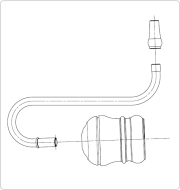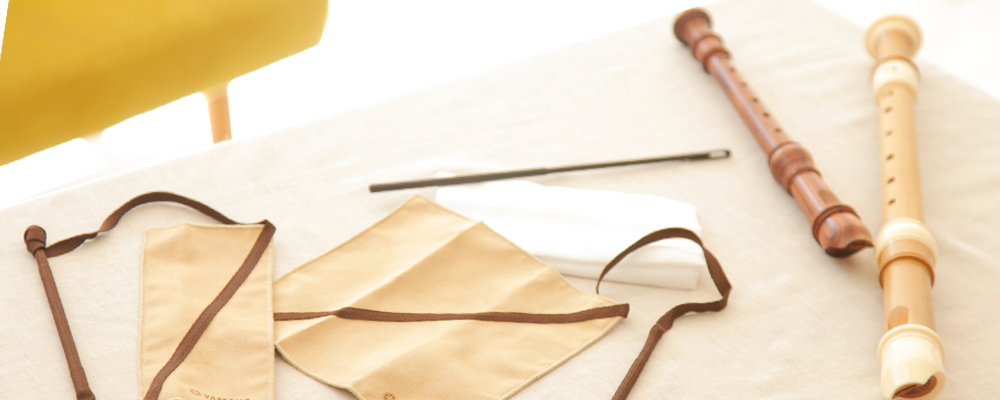Care and Maintenance of a Recorder
Caring for you recorder
"Conditioning" needed for wooden recorders
When brand new wooden recorders are purchased, they require "conditioning."
If they are played suddenly for a long period of time, swelling due to sudden absorption of moisture by the block can deform the instrument, and in severe cases cause it to break.
Accordingly, condition the instrument for exposure to moisture by blowing into it and producing sound a little each day, to cultivate a resounding tone.
During the first week of use, aim to condition the instrument for around 15 minutes each day. If it feels as though the windway has become clogged in under 15 minutes, stop playing immediately and remove all moisture.
Gradually extend the duration of performances using the instrument. Maintenance is recommended around once every six months. At this time, the block is sometimes found to have swollen without returning to its original shape. When that occurs the block can be adjusted by filing (revoicing).
Before performances
Before playing the recorder, wash your hands clean, and always endeavor to brush your teeth and gargle. If food debris is present in the mouth, it can become clogged in the windway and cause mold to develop.
Also, it is important to warm the bore of the instrument before playing it. This is especially important in winter. If the instrument is played suddenly when cold, the following may occur:
- The pitch may become flat, and become out of tune with other instruments.
- The instrument may not produce a good quality sound.
- The windway may become clogged with condensation.
- Breakage can occur in wooden instruments.
In winter, rooms indoors can often become dry. Care is needed, as this can also cause breakage in musical instruments.
Warm the body of the recorder, using the palm of your hand for example, or heat it indirectly with a hand warmer or similar heat source, avoiding direct contact. Recorder cases that work like electric heated pads are also available.
While these details are less important in summer than in winter, exercise caution with air conditioning and avoid cooling the instrument in the flow of air they emit. It is also necessary to take care to dry the instrument thoroughly during the rainy season, to avoid mildew.
After performances
Both wooden and resin recorders should be dried using gauze wrapped around a cleaning rod to remove moisture from within the instrument. (A cleaning swab can be used instead of gauze.)
With wooden recorders, after the moisture has been wiped from the interior of the bore, allow the instrument to dry thoroughly before storing it in the case.
Resin recorders can be washed in one piece using a neutral kitchen detergent.
For instruments equipped with keys, take care to avoid allowing the keys to become wet.
Grease should be applied to any cork joints when assembling a recorder, but it is not necessary to wipe the grease away every time.
Everyday care
Always store your recorder safely in its case, and take care not to store it in any locations such as those described below.
- Locations exposed to direct sunlight
- Close to naked flames from sources such as cooking stoves
- Locations affected by flowing water or rain Locations with high humidity
- Locations with high levels of dust or dirt
Also, as the labium is a part of the instrument that is particularly important in terms of producing sound, exercise care to ensure it does not become damaged.
When the windway becomes clogged
If condensation forms in the windway while the instrument is being played and the timbre becomes muffled, like the voice of someone who has caught a cold, use a finger to cover the window of the instrument lightly and blow into it forcefully to expel any clogged moisture. While the finger is covering the window, clear a passage through the condensed moisture so that sound is restored.
If the edge is touched directly with the finger, the condensed moisture will block the airway through the instrument, so this is not effective. If doing this during a performance, take care to ensure the sound of blowing cannot be heard.
Also, by sucking a little as though using a straw, moisture that has adhered to the interior of the windway can be reduced.
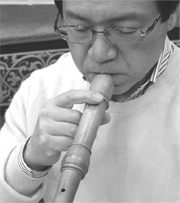
Photograph of blowing into the instrument while covering the windway with a finger. Modelled by Minoru Yoshizawa (recorder player)
Another method is to position the head joint so that the front faces upward, hold the palm of the hand against the joint (the part that connects to the middle joint) as it is held horizontally (either left or right hand can be used), then blow into the window with a short, strong breath. When this is done, moisture that emerges from the mouthpiece can then be removed. This method may be preferable for those who would rather avoid touching the labium directly.
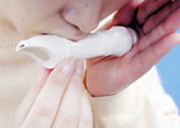
Blowing hard into the window
If the joints of the recorder become loose?
With a recorder, everyday handling is important. With an ABS resin recorder that has become loose, apply recorder cream generously.
Repair wooden recorderby replacing the cork that surrounds the joint, or winding fine thread around the cork from the base. As musical instrument stores that can make such adjustments to the cork using a spool of thread are limited, it is best to confirm whether this is possible.
For plastic recorders, ensure that the joints are always adequately greased, so that plastic parts in direct contact with one another do not chafe and wear.
Handling and care of tenor and bass recorders
Care should be taken regarding in following additional areas when handling and caring for tenor recorders and bass recorders.
Joint fittings
Take care not to grip the keys tightly while putting the joints together. If held by the keys, the alignment of the pads could be damaged, causing air to leak during play.
Care of keys and pads
-
Remove dirt and moisture from pads
When the pads are moist after or during a performance, place absorbent paper that is about as thin as tissue paper (such as cleaning paper) between the pad and the tone hole, and lightly press the pad. Repeat 2-3 times, moving the paper each time.
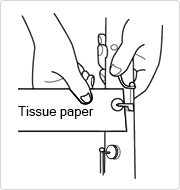
-
Key care
Apply key oil from time to time where the key posts are attached to the keys. This is beneficial to the movement of the keys, and improves resistance against rust. While applying oil, take care to avoid soiling the pads with oil.
Also, be sure to fasten the key screw before playing the instrument. When loose this can cause noise, which can be detrimental to the performance.
Key oil viscosity
Key oil with a viscosity of around #300 is appropriate for tenor recorders (sold separately for use with clarinets).
About the bass recorder
With a structure such as that shown in the diagram, when attaching or detaching the cap from the head joint, take care not to grip the blowpipe tightly. Holding the blowpipe too tightly can bend it out of shape.
Also, as with the interior surfaces of the rest of the instrument, ensure moisture is thoroughly removed from the mouthpiece of the bass recorder after every performance.
